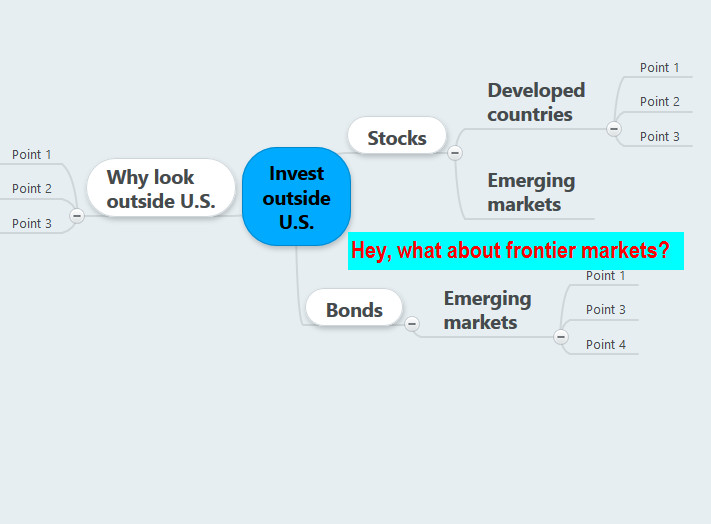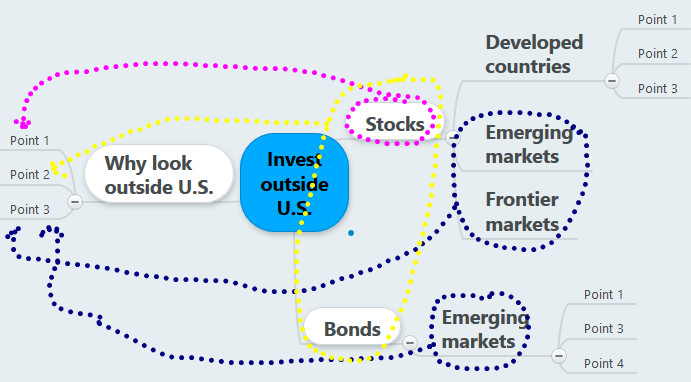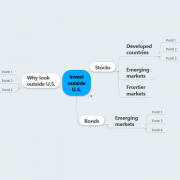Mind maps: can they win buy-in for your writing?
“Do you ever circulate mind maps for buy in from executives at firm that you are writing for? For example, chief investment officer or marketing executives?” This question arose during my latest investment commentary webinar. I am a big fan of using mind maps in the writing process.
Most people know mind mapping as a visual, nonlinear way of brainstorming ideas. You put your ideas on paper so you can look at them from a bird’s eye perspective. This lets you identify patterns, prioritize ideas, and organize, without getting bogged down in details.
I rarely share mind maps with my clients, but I’ve found them powerful in the right situations. My experience sparked some thoughts about how you might use them to win over your bosses or subject-matter experts as you develop investment commentary, white papers, or other content for your investment or wealth management firm.
The right time to introduce mind maps will depend on the person whose buy-in you seek. Are they open to visual aids or do they need to see ideas fully written out? Will they brainstorm with you? Can they commit to content at the idea stage?
Here are some ways that you might introduce mind maps into your approval process. By the way, unless you’re a very neat writer, you should use mind mapping software to produce readable maps. I currently pay for a subscription to MindMeister, but there are many other options.
1. Brainstorm with your subject-matter expert or marketer
At the brainstorming stage, your mind map identifies what you think will be your main themes. However, you haven’t yet finalized your themes or organization. Your map will be messy. It may overwhelm a viewer who craves order or who’s not used to looking at mind maps.
However, if you’re working with a person who likes to brainstorm, then a mind map that displays relevant ideas can help you discuss which of the many possible paths you should take. For example, you might point to a cluster of ideas around a specific asset class. Do you focus a section on that asset class or do you integrate it into a discussion of a broader trend that also appears on your diagram?
This might be especially helpful if you work with subject-matter experts who typically go through several drafts because they need multiple drafts to spark new ideas. Your mind map could accelerate their ability to see new ideas and connections with different parts of your mind map.
Mind mapping software can help you and the other person collaborate. You can allow more than one person to edit the mind map. Participants can also add relevant links and documents, such as an Excel spreadsheet or a provocative article.
In the example below, the participants realized that they’d forgotten to consider frontier markets.

2. Review your overall approach to the topic
If you want someone to sign off on your “big picture” approach to a topic, consider showing them a second-round mind map.
When I write complex stories, I use the first mind map to identify my themes and organization. Then, I draw a second mind map that’s organized to show only relevant information in the order in which I think it will work best. When you show someone a second-round mind map, they won’t be distracted by other potential directions. Plus, they can more easily grasp your plan than in a first-round mind map, where you may need to explain how you’ll reshape the raw data.
Why not just show them an outline? An outline takes more time to write. Plus, it makes the organization seemed more final. That’s not good if you want to encourage them to tweak your approach to improve it.
Viewing the next mind map helped the participants decide that their piece should be organized in terms of the three broad reasons to invest outside the U.S. The dotted lines show the topic areas from which they’ll draw their evidence.

3. Dig into the details
If your colleague wants to see all of the supporting details before you write, mind maps can help.
If you’re writing a short piece, you might drop all of your data into a mind map before reviewing it with your expert or other co-worker. For a longer piece, that’s too time-consuming. However, if you use software to attach a file or a link with detailed data, then you easily answer your co-worker’s questions about the nitty-gritty details.
4. Diagnose what’s wrong
In direct interactions with clients, I’ve most frequently used mind maps to diagnose what’s wrong with written pieces.
I’ve sometimes done this interactively with clients looking at my mind map in MindMeister from their desks somewhere else in the U.S., while I work in my office. I start with a map in which I’ve diagrammed the piece’s current organization. If the piece is short enough, I go paragraph by paragraph and sentence by sentence.
One of the big questions I ask is essentially, “Does the piece place like with like?” Placing like with like is a “Key lesson for investment commentary writers from my professional organizer.” The visual aspect of mind mapping makes it easier for my coaching clients to see that content is misplaced.
5. Harvest ideas for the next piece
Financial writers always need more ideas for future articles, investment commentary, and white papers. Look at your original mind map with your subject-matter expert or other colleague. You may identify gems that didn’t fit in your current project.
Don’t force mind maps on people
Some folks love mind maps. Others can’t stand them. Even if you love them, you can’t force someone whose mind works differently to join in your enthusiasm. Don’t push it.



